The Jacobite-Williamite War – An overview
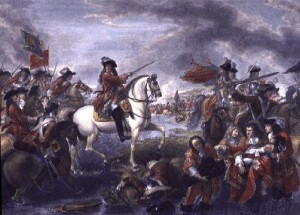
The War between King James and King William in 1689-91, that decided the fate of Ireland. By John Dorney
Every year on July 12, Orangemen in Northern Ireland march to commemorate the victory of William of Orange ‘King Billy’ over the Catholic King James at the Battle of the Boyne in 1690.
In fact the Boyne took place on July 1, 1690 and originally Protestants commemorated the culminating battle of Aughrim, fought on July 12, 1691, on the Twelfth. But no matter, the Boyne is still commemorated because of its symbolism.
Every year on July 12, Orangemen in Northern Ireland march to commemorate the victory of William of Orange over the Catholic King James at the Battle of the Boyne in 1690.
For at the Boyne were present two kings, one the Catholic James Stuart, King of England, Scotland and Ireland, supported by France of Louis XIV and most of Ireland’s Catholics, representing, supposedly, absolutism and tyranny.
And on the other side was the Protestant William of Orange, Stadtholder of the Dutch Republic, and claimant to the throne of the Three Kingdoms, supported by the English Parliament, most of Ireland’s Protestants and by a coalition of Protestant powers including Denmark and William’s native Netherlands.
According to the ‘Whig’ (English Liberal) and indeed the Orange tradition, William’s force stood for religious freedom, representative government and the rule of law.
For Irish Catholics or ‘Jacobites’ – supporters of King James – the war was a great defeat – leading to an era of broken Treaties, oppression, and religious persecution. ‘Cuimhnigi Luimneach agus feall na Sassanaigh’ was a popular saying in 18th century Ireland – ‘remember [the Treaty of] Limerick and English treachery’.
It seems curious at this remove that such a war was fought so fiercely and is still commemorated so fervently in Ireland today. Was it not after all, just a squabble between two foreign kings for the throne of England? Indeed in the Irish language the war was known as ‘Cogadh an Da Ri’ or the War of the Two Kings.
But in fact, the fate of Ireland was inseparably bound up with who held power in England and in the 17th century, religious identity was not something that could be avoided. Access to land, political power, and even to the law all depended on one’s allegiance to one or other faction. The Jacobite-Williamite War or ‘War of the Two Kings’ – notwithstanding the mythology it subsequently produced, really was a watershed event in the history of Ireland.
Background
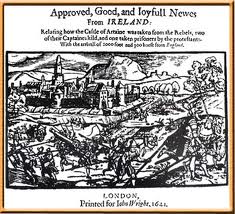
The War of the Two Kings was the culmination of over a century of ethno -religious wars and strife in Ireland.
By the early 17th century the English state had for the first time overcome the independent Gaelic lordships and established political control over the whole of the Kingdom of Ireland – governed by an English administration in Dublin Castle.
Large colonies of English and laterally Scottish, settlers had been ‘planted’ in Ulster, Munster and Leinster, in land confiscated from rebellious Irish lords, to secure the conquest.
With political control came also religious domination. The Protestant Anglican Church was made the established Church of the Kingdom, it inherited all Church property and attendances at is services were made compulsory, with non-attendance punished by fines.
The seventeenth century was a time of religious war in Europe and in Ireland it had the added force of conquest, colonisation and resistance.
More importantly, deviance in religion meant that Catholics could not hold government posts and opened the possibility of the confiscation of the land of the Catholic gentry.
While most of the new English and Scottish settlers were Protestants, the large majority of the pre-Conquest Irish population, both Gaelic and ‘Old English’ in origin, were Catholics.
In 1641, Catholics rose in rebellion, in an attempt to redress these grievances, triggering a ferocious eleven year war. This ended in Oliver Cromwell’s re-conquest of Ireland on behalf of the English Parliament and the total dispossession of the Catholic land-holding class.
One of the complicating factors of that war was that it coincided with Civil War and Revolution in England itself. Catholics in Ireland claimed to be loyal to the Stuart Monarchy while Protestants allied themselves with the English Parliament.
Irish Catholics felt the had been penalised for loyalty to the Stuart monarchy while Protestants had been rewarded for ‘rebellion’ in siding with the Parliament and Cromwell.
So when Cromwell died in 1660, the Commonwealth or Republic he had founded fell apart and the Stuart monarchy was restored, Irish Catholics expected to be rewarded for their loyalty and to be returned the lands they had lost.
This did not happen however. Only a minority of high ranking Royalist Catholics received their lands back in the Restoration and Catholics remained excluded from political power.
Charles II, son of the executed Charles I, owed his restoration as King to the Army, many of whom (as part of Cromwell’s New Model Army) had been granted confiscated land in Ireland. Nor was there much sympathy for Irish Catholics in England, where it was believed that the Irish had wantonly massacred thousands of Protestants settlers in the rebellion of 1641. As a result, the Cromwellian settlement, which had eliminated all Catholic landholdings except in the province of Connacht, was largely allowed to stand.
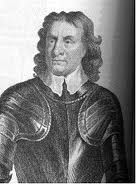
While the war of mid century had in many respects been an ethnic and religious war in Ireland, rather than a contest between King and Parliament, Catholics complained they had been punished for their loyalty to the Crown while Protestants had been rewarded for their rebellion against it.
This all changed when James II, a Catholic, came to power in 1685. James did not overturn the land settlement in Ireland, but he did allow Catholics to return to political power, appointing one, Richard Talbot, Earl of Tyrconnell as Lord Deputy of Ireland, effectively the governor of the country. Talbot was far from a Gaelic chieftain, he was the scion of an old English Pale family, but he emerged as the leader of the Catholic political interest.
As Lord Deputy, Talbot not only filled his administration with Catholics, he also re-admitted Catholics to the Army, including the officer corps, arming and training the representatives of a disgruntled and revanchist majority.
Protestants in Ireland feared at best, a Catholic takeover of the government of Ireland and a dismantling of the Cromwellian land settlement and at worst, a repeat of the massacres of 1641, during which they believed that Catholics had attempted to kill or expel their community in its entirety.
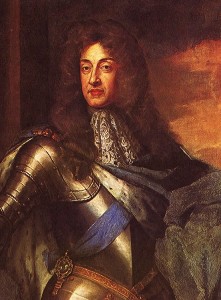
James was later painted a potential tyrant who would have been an absolutist monarch in the mould of Louis XIV of France.
However, in at least one respect, James’ reputation as an enemy of ‘civil and religious freedom’ is undeserved. In 1687 he decreed that there would be liberty of conscience for all religions within his three kingdoms, including both Catholics and Protestant non-conformists as well as the official Anglican Church.
However, James II had a difficult relationship with the English Parliament and when his wife gave birth to an heir, they began to intrigue with foreign Protestant powers in order to prevent James founding a Catholic dynasty in England. In 1688 elements of the Parliament offered the throne of England to William of Orange Stadtholder (effectively President for life) of the Netherlands.
When James was deposed in England in 1688, the Catholics of Ireland became his last means of recovering his throne.
William needed the support of England against France as the head of coalition of European powers, including as it happens, the Papacy, worried by Louis XIV’s aggressive expansionism.
And so in 1688 William invaded England with a strong Dutch Army. Elements of the English Army defected to William after his landing and James fled the country for France after minimal resistance. The Parliaments of England and Scotland judged James to have abdicated and declared William to be King and his wife, James’ daughter Mary, to be Queen.
But in Ireland the Jacobites – Catholic supporters of James – were not only the majority but they also controlled the Army. They quickly secured most of the fortified towns and cities in the country and declared that James was still the rightful King of Ireland.
The stakes in Ireland were higher, in a sense, than for most in England or Scotland. In Ireland both Catholics and Protestants believed that their lands, political futures and even their lives depended on having their coreligionist as King.
The Siege of Derry
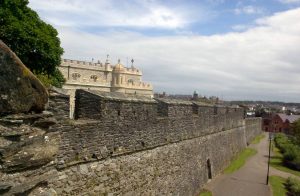
Protestant resistance to the Jacobite regime was initially crushed. Justin McCarthy, Viscount Mountcashel put down a Protestant Williamite (supporters of William) rebellion at Bandon, County Cork and in Dromore, County Down a rising of local Williamites was also easily defeated.
Only in the walled city of Derry, in the north west, did the Protestant Williamite minority hold out.
Derry or Londonderry was an almost exclusively Protestant town, having been founded during the Ulster Plantation with funds from the banks of the city of London. Now its citizens closed the city’s gates to the Jacobite Army that approached it and went on to endure a four month siege by Jacobite forces.
The Protestant walled city of Derry held out against Jacobite forces for four month in 1689.
However, in July 1689, Derry was relieved by ships from England that sailed up the river Foyle, breaking the Jacobites’ blockade of the city. The Williamite resistance at Derry was strategically not terribly important, but psychologically it was a great boost to Protestant Wiliamites, their first victory of the campaign in Ireland. The siege is still annually commemorated and is the origin of loyalist slogans such as ‘No Surrender’.
Not long after the siege was broken, the Jacobites were driven from north west Ulster altogether, when their forces were routed by local Williamite militias, at a battle at Newtownbutler, near Enniskillen.
Meanwhile, it had become clear that Ireland would become the battleground where the thrones of England, Ireland and Scotland would be fought over.
James himself had arrived in Ireland on March 12 1689, along with French money and 6,000 troops, sent by Louis XIV of France, in a first step to recover his throne. William sent a Dutch general, Schomberg, together with a contingent of English and Dutch forces, to put down Jacobite resistance, landing at Carrigfergus in north east Ulster, where Protestant settlement was largest and Williamite support was strongest, in August of 1689.
There followed a period of inconclusive campaigning around southern Ulster and Dundalk in the autumn of 1689, in which both Jacobite and Williamite armies circled around each other but did not come to battle. Nevertheless, thousands of Schomberg’s troops died of disease in his insanitary camps and he was forced to retire to winter quarters.
William of Orange decided that he had to come to Ireland to finish the job himself and arrived with further reinforcements at Carrigfergus in June of 1690.
Jacobite Ireland
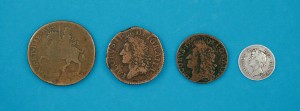
While James had little interest in Ireland in and of itself, viewing it mainly as a means of recovering the throne of England, for his supporters, the Irish Jacobites, it was a chance to reverse more than a century of English and Protestant domination. There were some Protestant Jacobites, who viewed James as the lawful King and William’s accession to the throne as an illegal putsch, but by and large this was an Irish Catholic movement.
The Jacobite Irish Parliament voted to overturn the Cromwellian land settlement, abolish religious discrimination and assert the equality of the Irish parliament with its English equivalent.
At both elite and popular levels, there were clear signs that this was a kind of ‘proto-nationalism’. At an elite level this was manifested in the Irish Parliament that met from May to July 1689. It was a conventional parliament of the era, elected by a highly restricted franchise of landowners, containing both a House of Commons and of Lords, whose purpose was not to govern but rather to debate and ratify new laws and new taxation.
But, as well as officially recognising James as the legitimate monarch of the Three Kingdoms, the parliament also attempted to advance the Irish Catholic cause.
It overturned the Cromwellian land settlement, restoring to Catholics all lands confiscated since the 1650s, removed both religious and political discrimination against Catholics and dissenters and passed a law stating that the English Parliament could no longer pass laws relating to Ireland without the consent of the Irish parliament. If not quite a declaration of independence, it was certainly an insistence on Ireland’s equality within the Stuart Kingdoms.
If Irish Williamites may have been comforted by the fact that the Jacobite parliament had favoured freedom of religion over Catholic supremacy, they were probably less so by the fact that a further Bill named 2,000 Williamites as traitors and rebels against their lawful sovereign, whose lives and property were to be forfeit in the event of a Jacobite victory.
At a more popular level, it is also possible to discern public engagement with Jacobite cause. It was popularly taken up in the Irish language poetry of the day and outside of the formal Jacobite armies, marauding bands of guerrillas known as rapparees – some led by characters such as Hugh Baldearg O’Donnell, who claimed to be the rightful heirs of the old Gaelic lords – also harassed Williamite forces.
With all that said, the short-lived Jacobite administration in Ireland was plagued with problems. They were perennially short of money, dependent on French subsidies to keep their armies in the field and resorted to increasingly desperate measure in order to finance the war.
Initially they tried to enforce a property tax and then, when that failed to collect enough money, they attempted to mint their own currency, derisively termed ‘gun-money’ by their Williamite enemies, as it was supposedly composed of melted down brass from cannon barrels. Nevertheless Jacobite soldiers were rarely paid and were badly supplied and equipped.
The Battle of the Boyne
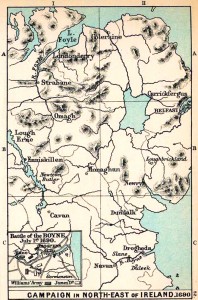
The turning point of the war came when William marched south on Dublin with a large army of over 36,000 men in June of 1690.
James’ forces, outnumbered by about 3-2, offered resistance at the river Boyne, just to the west of the town of Drogheda. On July 1, 1690 the Williamites successfully crossed the river at a number of points and forced the Jacobites into retreat.
Though there was some hard fighting in and around the river crossings, notably at the village of Oldbridge, casualties were fairly light on both sides. The Jacobite army retreated but was not pursued effectively due to determined counter attacks by Jacobite cavalry.
It might well be pondered, then, why the battle of the Boyne is viewed today as such a decisive turning point in Irish history. Neither army had been destroyed or even greatly weakened. The Williamites had crossed the river but still had yet to approach, let alone take Dublin.
The Battle of the Boyne was not militarily decisive, but it broke James’ fragile morale and he fled the country.
The main reason for the Boyne’s significance is that it precipitated a collapse in James’ confidence. Witnessing the repulse of his army at the Boyne and the subsequent disorderly retreat to Dublin, he despaired of victory and within days had ridden to the port of Duncannon and from there took ship back to France. In other words, the defeat at the Boyne convinced James, quite prematurely, that he had lost the war.
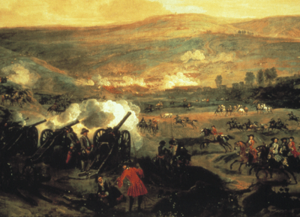
James’ flight temporarily discomfited the Jacobites, who abandoned Dublin without a fight and retreated west of the river Shannon. William entered the Irish capital in triumph on July 27, about four weeks after his victory at the Boyne.
In spite of this, the Jacobites in Ireland fought on, not so much in the hope of James’ restoration now, as in safeguarding some of the gains they had made regarding Catholic landownership and freedom of religion.
Neither of these was mentioned by William in peace terms he published at Finglas, just before he entered Dublin, in which he offered pardon to the Jacobite rank and file but not the ‘desperate leaders of the rebellion’.
Contrary to William’s hopes, the anticipated large scale surrenders did not materialise. Rather the Jacobites managed to reform their army and took up quarters in and around the city of Limerick, in the west.
Sarsfield and the Siege of Limerick
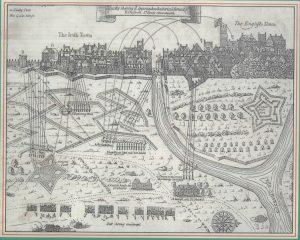
Wanting to to get the campaign in Ireland over with, William marched west to besiege Limerick. However his artillery train was ambushed and destroyed by a daring cavalry raid carried out by the emerging Jacobite leader Patrick Sarsfield.
When more big guns were brought up from Waterford, the Williamites battered a breach in Limerick’s walls and mounted a direct assault on August 27.
In subsequent fierce fighting in the breach, the Williamites crack Dutch and Danish troops suffered severely, up to 3,000 being killed and wounded by close range musket and cannon fire and even stones and other missiles hurled by the townsmen and women of Limerick.
After his repulse at Limerick, William withdrew his forces east of the Shannon, though the Williamites did successfully besiege and take the ports of Cork and Kinsale on the south coast. William himself left Ireland and put his forces under the command of a Dutch general Godert de Ginkel.
The Williamite attempts to take Limerick were repulsed in August 1690.
The objective of the French in Ireland had always been, not so much Jacobite victory, still less the restoration of Catholicism there, as prolonging the war and diverting English and Dutch resources from war fronts in continental Europe. And for this reason, after the Jacobites’ defence of Limerick, Louis XIV sent more troops, money and a new commander, the Marquis of St Ruth, to Ireland in late 1690.
The battle of Aughrim and the end of the war
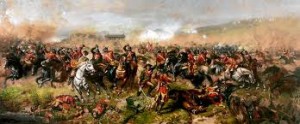
Warfare in the 17th century was very much dependent on the seasons. Large armies simply could not be moved or fed in the winter months and so it was not until the following summer of 1691 that the Willamite forces under Ginkel again tried to smother the Jacobite enclave in the west of Ireland.
Following a hard fought siege at Athlone, which commands the main crossing over the river Shannon, the Williamites marched towards Limerick. The Jacobites met them at the village of Aughrim, a hamlet astride the roads towards the towns of both Galway and Limerick.
At Aughrim the main Jacobite field army was destroyed.
There followed an all-day battle, on July 12, 1691, perhaps the bloodiest in Irish history, in which the Jacobites resisted numerous Williamite attacks, until the death of their commander St Ruth – his head was taken off by a cannon ball- and the flight of their cavalry forced them to give way. Much of their army was destroyed in the subsequent rout, cut down by pursuing Williamite horsemen. Thousands of bodies lay unburied on the hillside at Aughrim for months afterwards.
The Jacobites retreated to Limerick again, but this time they were greatly weakened and with their morale shattered. After enduring a siege for several months, during which Richard Talbot Earl of Tyrconnell died of disease, Patrick Sarsfield ousted the French commanders and negotiated a surrender.
‘Remember Limerick’
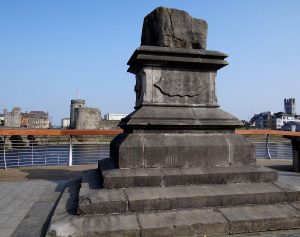
Sarsfield signed the Treaty of Limerick, with Ginkel, under which Sarsfield and over 10,000 Jacobite soldiers were to leave for France to continue to serve King James there.
More importantly, the Treaty gave guarantees that no more Catholic owned land would be confiscated and no more discriminatory legislation would be passed against the Catholic religion than had existed prior to James’ accession to the throne.
And so the ‘War of the Two Kings’ was ended in a relatively orderly and humane manner. There were no massacres of the defeated and fairly conciliatory terms for former Jacobites as long as they pledged allegiance to William. William after all, and his Dutch generals had little particular interest in Irish affairs. Their only real motivation was in a prompt end to the war in Ireland and to its use as a military base by James and the French.
The Treaty of Limerick gave lenient terms to the Jacobites, but many were later abrogated by the all-Protestant Irish Parliament.
However, the now all-Protestant Irish Parliament that met in 1692 was a very different proposition. They most certainly had an interest in making sure that no attempt would again by made to overturn Protestant supremacy in Ireland and quickly set about confiscating land from former Jacobite supporters and from 1695 onwards, passed series of Penal Laws against Catholics.
These laws, aside from religious provisions against the Catholic Church, also barred Catholics from holding public office, serving in the Army, bearing arms and owning land over a certain amount.
All of which was indeed quite successful at making sure that there were to be no more Jacobite rebellions in Ireland in the coming century, even when they broke out in Scotland in 1715 and 1745. By the late 18th century only a fragment of the Catholic land owning class survived.
Thus, Catholics generally considered, in the decades that followed, that the terms of the Treaty of Limerick had been broken, indeed, treacherously so.
Legacy and memory
The ‘War of the Two Kings’ was the major military conflict of what is known in British history as the ‘Glorious Revolution’, in which Britain was, according to the national narrative, saved from absolutism and the monarch was forced to govern through a parliament and while respecting a bill of rights.
Obviously, when applied to Ireland, this narrative fits rather awkwardly. The war may have played a part in founding constitutional government – the Irish Parliament was to be a much more important institution throughout the 18th than before – but it also disenfranchised the majority of the population, not only Catholics but also Protestant ‘dissenters’ such as Presbyterians.
The popular memory of the war is complex and has changed over time.
Ireland in the 18th century was ruled by a small class of landowning Anglican Protestants, mostly of English stock.
It is therefore not surprising that the war was celebrated by the victorious Williamites and their descendants as a ‘deliverance from Popery and tyranny’. However the modern Orange tradition that keeps alive the memory today is in fact the product of a much later and more tangled history.
Throughout the 18th century, Irish Protestants commemorated the outbreak of the rebellion of 1641, when they believed their community had only just escaped extermination, more than the battles of Aughrim or the Boyne.
It was not until the 1790s, at a time when Catholics were again agitating for political rights and the Republican revolutionaries the United Irishmen were preparing for insurrection, the Orange Order was founded in Armagh. Its history of marching on the Twelfth of July in commemoration of the battle of the Boyne dates from this era and not from the 1690s.
Nevertheless even today the Orange Order states that it commemorates William’s ‘victory over despotic power laid the foundation for the evolution of Constitutional Democracy in the British Isles’.
On the other side, memory of the Jacobite cause was more complex. James II himself was mocked by Irish poets as ‘Seamus a chaca’ – ‘James the shit’ – the cowardly English King who had ‘lost Ireland’. But there was also a nostalgic genre of Jacobite poetry and songs throughout the 18th century that pined for the return of the ‘true king’, with the ‘Wild Geese’ or Irish soldiers who had left for French service, who together would who would rescue Irish Catholics from ‘slavery’.
The later Irish nationalist tradition would also rehabilitate many Jacobite heroes such as Patrick Sarsfield as fighters for Irish freedom and the nationalists like Thomas Davis and later Charles Gavin Duffy would christen the Jacobite parliament of 1689 as the ‘Patriot Parliament’ for its assertion of independence.
But unlike the Orange tradition, modern Irish nationalist and particularly Republican narratives tend to be uncomfortable with the Jacobites’ loyalty to an English monarch, let alone with ideas such as the divine right of kings, which James Stuart held to.
The War of the Two Kings, was a time when Ireland was briefly at the centre of European-wide struggle for power and also a decisive turning point in Irish history.